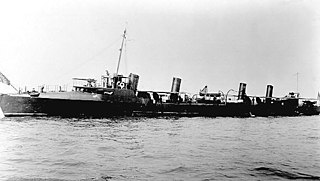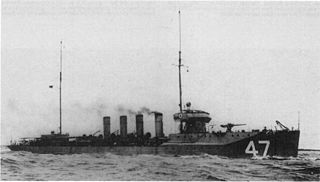
The fifth USS Boston was a protected cruiser and one of the first steel warships of the "New Navy" of the 1880s. In some references she is combined with Atlanta as the Atlanta class, in others as the Boston class.

The first USS Chicago was a protected cruiser of the United States Navy, the largest of the original three authorized by Congress for the "New Navy" and one of the U.S. Navy's first four steel ships.

The Florida-class battleships of the United States Navy comprised two ships: Florida and Utah. Launched in 1910 and 1909 respectively and commissioned in 1911, they were slightly larger than the preceding Delaware class design but were otherwise very similar. This was the first US battleship class in which all ships received steam turbine engines. In the previous Delaware-class, North Dakota received steam turbine propulsion as an experiment while Delaware retained triple-expansion engines.

The Benham class of ten destroyers was built for the United States Navy (USN). They were part of a series of USN destroyers limited to 1,500 tons standard displacement by the London Naval Treaty and built in the 1930s. The class was laid down in 1936-1937 and all were commissioned in 1939. Much of their design was based on the immediately preceding Gridley and Bagley-class destroyers. Like these classes, the Benhams were notable for including sixteen 21-inch (533 mm) torpedo tubes, the heaviest torpedo armament ever on US destroyers. They introduced a new high-pressure boiler that saved space and weight, as only three of the new boilers were required compared to four of the older designs. The class served extensively in World War II in the Atlantic, Mediterranean, and Pacific theaters, including Neutrality Patrols in the Atlantic 1940-1941. Sterett received the United States Presidential Unit Citation for the Battle of Guadalcanal and the Battle of Vella Gulf, and the Philippine Republic Presidential Unit Citation for her World War II service. Two of the class were lost during World War II, three were scrapped in 1947, while the remaining five ships were scuttled after being contaminated from the Operation Crossroads atomic bomb tests at Bikini Atoll in the Pacific.

The Pennsylvania class of six armored cruisers served in the United States Navy from 1905 to 1927. All six were renamed for cities 1912–1920, to make the state names available for the new battleships beginning with the Pennsylvania-class battleships. All of these served during World War I, with California being the only ship of the class to be lost. The remaining five armored cruisers were scrapped between 1930 and 1931 in accordance with the London Naval Treaty.

The Delaware-class battleships of the United States Navy were the second class of American dreadnoughts. With this class, the 16,000 long tons (16,257 t) limit imposed on capital ships by the United States Congress was waived, which allowed designers at the Navy's Bureau of Construction and Repair to correct what they considered flaws in the preceding South Carolina class and produce ships not only more powerful but also more effective and rounded overall. Launched in 1909, these ships became the first in US naval history to exceed 20,000 long tons (20,321 t).

Three Truxtun-class destroyers were built for the United States Navy. Part of the original 16 destroyers authorized by Congress on 4 May 1898 for the fiscal year 1899 program, they were commissioned in 1902. They were very similar to their Bainbridge-class contemporaries, except for mounting six 6-pounder (57 mm) guns instead of five. They were considered the most successful of the first 16 US Navy destroyers, and were succeeded by the larger Smith class.

The Bainbridge-class destroyers were a class of United States Navy Torpedo Boat Destroyers (TBDs) built between 1899 and 1903. The first class so designated, they comprised the first 13 of 16 TBDs authorized by Congress in 1898 following the Spanish–American War. One ship of the class was lost at sea during service in World War I: Chauncey, which collided with the British merchant ship SS Rose in 1917. The balance were decommissioned in 1919 and sold postwar in 1920, eleven to Joseph G. Hitner of Philadelphia, and the Hopkins to the Denton Shore Lumber Company in Tampa, Florida.

The Smith-class destroyers were the first ocean-going destroyers in the United States Navy, and the first to be driven by steam turbines instead of the reciprocating engines fitted in the sixteen earlier and much smaller torpedo boat destroyers ordered in 1898. Flusser and Reid are sometimes considered to be Flusser-class ships. Also, since Flusser was completed first, some period documentation refers to the entire class as Flussers.

The Paulding-class destroyers were a series of United States Navy destroyers derived from the Smith class with the torpedo tubes increased from three to six via twin mounts. They were the first destroyers in the US Navy with oil-fired boilers. The 21 Pauldings doubled the number of destroyers in the US Navy. The Paulding class derived its name from the class's lead ship, Paulding, named for Rear Admiral Hiram Paulding (1797–1878). Like the Smiths, they were nicknamed "flivvers" after the small and shaky Model T Ford once the larger "thousand tonner" destroyers entered service.

Four destroyers in the United States Navy comprised the Cassin class. All served as convoy escorts during World War I. The Cassins were the first of five "second-generation" 1000-ton four-stack destroyer classes that were front-line ships of the Navy until the 1930s. They were known as "thousand tonners" for their normal displacement, while the previous classes were nicknamed "flivvers" for their small size, after the Model T Ford.

The Aylwin class was a class of four destroyers in the United States Navy; all served as convoy escorts during World War I. The Aylwins were the second of five "second-generation" 1000-ton four-stack destroyer classes that were front-line ships of the Navy until the 1920s. They were known as "thousand tonners". All were scrapped in 1935 to comply with the London Naval Treaty.

The New Orleans class of protected cruisers of the United States Navy consisted of two ships which were building for the Brazilian Navy at Elswick, near Newcastle Upon Tyne, England, by Armstrong Whitworth. The Brazilian Navy had ordered four Elswick cruisers, but had already sold the first ship during construction to Chile as Ministro Zenteno. One ship was delivered to Brazil, named Almirante Barroso. The third ship was fitting out as Amazonas, and the fourth was on order as Almirante Abreu.

The Somers-class destroyer was a class of five 1850-ton United States Navy destroyers based on the Porter class. They were answers to the large destroyers that the Japanese navy was building at the time, and were initially intended to be flotilla leaders. They were laid down from 1935–1936 and commissioned from 1937–1939. They were built to round-out the thirteen destroyers of 1,850 tons standard displacement allowed by the tonnage limits of the London Naval Treaty, and were originally intended to be repeat Porters. However, new high-pressure, high-temperature boilers became available, allowing the use of a single stack. This combined with weight savings allowed an increase from two quadruple center-line torpedo tube mounts to three. However, the Somers class were still over-weight and top-heavy. This was the first US destroyer class to use 600 psi (4,100 kPa) steam superheated to 850 °F (454 °C), which became standard for US warships built in the late 1930s and World War II.

The Derfflinger class was a class of three battlecruisers of the Imperial German Navy. The ships were ordered for the 1912–13 Naval Building Program of the German Imperial Navy as a reply to the Royal Navy's two new Lion-class battlecruisers that had been launched a few years earlier. The preceding Moltke class and the incrementally improved Seydlitz represented the end of the evolution of Germany's first generation of battlecruisers. The Derfflinger class had considerable improvements, including a larger primary armament, all of which was mounted on the centerline. The ships were also larger than the preceding classes. The Derfflinger class used a similar propulsion system, and as a result of the increased displacement were slightly slower.

The St. Louis-class cruisers were a class of three cruisers that served in the United States Navy at the beginning of the 20th century. Authorized in fiscal year 1901 by an Act of Congress of 7 June 1900 as part of the naval buildup touched off by the Spanish–American War, the St. Louis-class cruiser initially began as an improved Olympia. However, during the design phase, decisions were made that increased the size of the vessel from 6,000 long tons (6,100 t) to 9,700 long tons (9,900 t), including adding protection that resulted in the designation "semi-armored cruiser". This led to a larger power plant, and other decisions were made to try to increase speed and range, such as using smaller 6-inch (152 mm) guns instead of 8-inch (203 mm) guns, and adding coal capacity. The completed ship at 9,700 long tons was the same displacement as a full armored cruiser without the same armor. One reference describes the class as "among the earliest well-documented examples of creeping growth in warship design".

The Columbia-class cruisers were two protected cruisers constructed in 1890 and 1891 and used by the United States Navy. They were lightly gunned ships with only moderate armor that were built for the speed needed to overtake and destroy the fast ocean liners of the day as commerce raiders. However, the light armament and armor left these ships over-specialized and outclassed by ordinary similar sized protected cruisers that they might encounter. Also, the engines were expensive to operate and at full power the ships' range was greatly decreased. Due to the ongoing size and speed race in ocean liners, by 1907 they were outclassed in speed by the ill-fated Lusitania and the German liner Kronprinzessin Cecilie.

The Denver-class cruisers were a group of six protected cruisers in service with the United States Navy from 1903 through 1929. Authorized by Congress in 1899 as part of the naval buildup touched off by the Spanish–American War, they were designed with peacetime duties on foreign stations and tropical service in mind, specifically patrolling Latin America and the Caribbean. However, they had insufficient armament, armor, and speed for combat with most other cruisers. Thus, they were also called "peace cruisers" and were effectively gunboats. They were intended to augment the Montgomery class in these roles.

The Cincinnati-class cruisers were two small protected cruisers built for the United States Navy in the early 1890s. They were smaller and more lightly armed and protected than most previous US cruisers, and were intended for commerce raiding. They may also be referred to as Raleigh-class cruisers, as Raleigh was launched and commissioned prior to Cincinnati.

The Montgomery-class cruisers were three unprotected cruisers built for the United States Navy in the early 1890s. They had a thin water-tight protective deck, and also relied for protection upon their coal bunkers, cellulose packing, and numerous compartments. Roomy accommodations were provided for officers and crew, these cruisers being mainly intended for long cruises on distant stations.




















